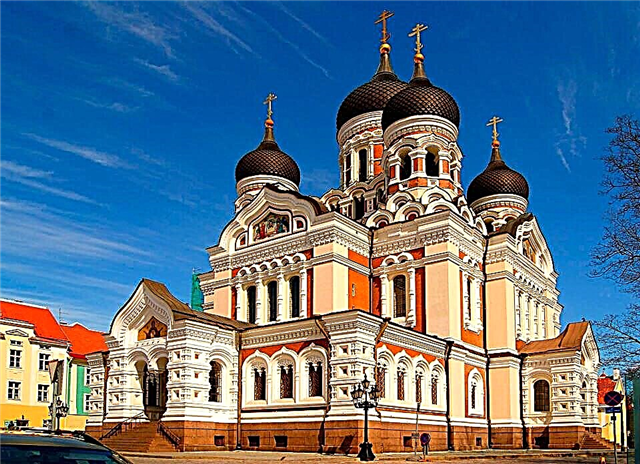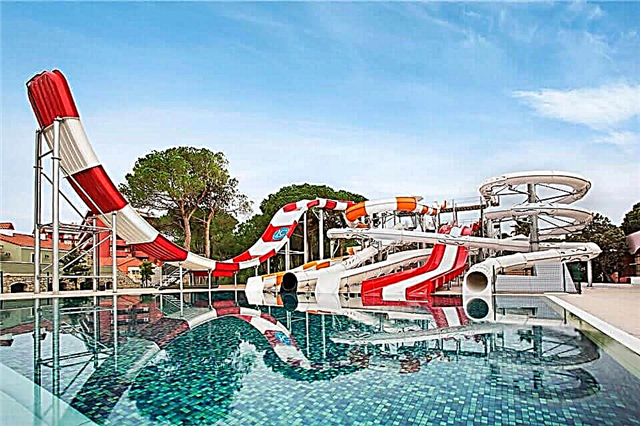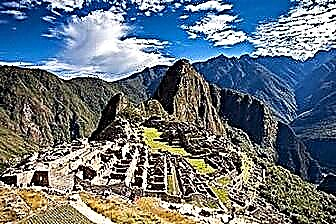Address: Russia, Yaroslavl region, Yaroslavl, st. Pervomayskaya, 19a
Foundation date: 1610 year
Main attractions: Cathedral of the Kazan Icon of the Mother of God, the Church of the Intercession of the Blessed Virgin Mary, the Church of the Presentation of the Lord
Shrines: the miraculous image of the Kazan Icon of the Mother of God, the relics of the priest Agafangel, Metropolitan of Yaroslavl
Coordinates: 57 ° 37'40.9 "N 39 ° 53'13.5" E
Cultural heritage site of the Russian Federation
Content:
Monasteries of Yaroslavl
The history of the monastery begins immediately after the Time of Troubles, from 1610 and has been going on for more than four centuries. During this time, the women's monastery developed, rebuilt, was abolished and today is reviving again. In memory of the talent of Yaroslavl architects, we are left with three beautiful temples, among which the majestic Kazan Cathedral occupies a special place - a vivid example of a cult building of the late classicism era.
History of the Kazan monastery
In 1609, Polish-Lithuanian troops besieged Yaroslavl for three and a half weeks, causing the city a lot of trouble. Then the Yaroslavl people believed that they managed to survive only thanks to the intercession of the miraculous image of the Kazan Mother of God. In gratitude to this icon, the townspeople built a wooden church near the defensive Earthen rampart. And soon, next to her, cells were built for 72 nuns of the Nativity monastery, which the Poles managed to burn. This is how the Kazan Women's Monastery was born.

Cathedral of the Kazan Icon of the Mother of God
Its first buildings and walls were made of wood. And the first brick church was built only in 1649. This was done through the efforts of the monastery priest Ermil Mikhailov and with the blessing of the Metropolitan of Rostov - Varlaam. However, 9 years later, during a huge fire that swept throughout the city, all the wooden buildings burned to the ground, and the stone temple was badly damaged. And it had to be rebuilt. The main chapel of the church was consecrated in honor of the famous Kazan icon, and the altar in the chapel was dedicated to Venerable Paraskeva of Serbia. Already under Metropolitan Ion Sysoevich, the interior of the church was painted, and in 1817 this painting was renewed.
They heard about the convent in Moscow, and she had the patronage of the tsar. In the letter of gratitude, signed by Tsar Alexei Mikhailovich, an order is given to establish the maintenance for each old woman living in the monastery in the amount of one ruble per year. It is known that in 1659, shortly after the fire, 112 nuns lived in the monastery, and after half a century - 132. Each of them lived by her own means, that is, initially, the monastery was not, as it was customary then to say, a community. The charter governing joint ownership was not adopted by the nuns until 1802.
Rich gifts from Moscow and wealthy families of Yaroslavl allowed the monastery to reconstruct the territory, buy expensive liturgical utensils and repair buildings. But until the 60s of the 18th century, most of the buildings in the monastery remained wooden.
The life of the monastic monastery year after year proceeded in traditional occupations. Its nuns kept house and prayed. Every year, a procession with the cross, which attracted many people, was held, during which the miraculous image of the Kazan Mother of God was carried. At first, believers reached the city of Romanov, and from the beginning of the 19th century - already to Rybinsk. The abbots were traditionally buried under the altar of the main cathedral of the monastery; in 1770, they began to bury ordinary nuns outside the monastery walls, allocating a place for their graves on the churchyard, which belonged to the Tolgsky monastery. This was done by decree signed by Tsarina Catherine II.
From the 1770s to the 1850s, extensive construction work took place at the monastery. Most of the funds for them were allocated by Catherine II. Over the years, old wooden and dilapidated stone buildings, including the wall, were replaced with new ones. New churches were built of bricks, one three-story and two two-story buildings for nuns, as well as a monastery wall with towers at the corners. All construction work was supervised by the abbess of the monastery Margarita (Smagina) and the Yaroslavl provincial architect Pyotr Yakovlevich Pankov.

Church of the Presentation of the Lord
In the mid-30s of the XIX century, they completely rebuilt, and in 1845 the main temple of the monastery was consecrated. Before that, the church was painted by an artel of craftsmen under the guidance of the famous iconographer Timofey Medvedev, and Yaroslavl carvers made a gilded three-tiered iconostasis for it.
The cloister occupied an entire city quarter, bounded from different sides by Varvarinskaya and Kazanskaya streets, as well as Teatralnaya square. The monastery was constantly improved. Therefore, by the beginning of the 20th century, there were 10 buildings for nuns (9 stone and 1 wooden) on its territory, in which 300 nuns lived. Salaries for abbess, nuns and clergymen were paid by the city treasury. According to the surviving documents, it is known that throughout history, both individual nuns and whole groups of nuns from the Transfiguration Church of the city of Romanov and the abolished Trinity monastery of the Yaroslavl diocese came to the monastery.
At the monastery there was a workshop for the manufacture of icons and gold embroidery production. Moreover, the quality of the embroiderers' work was very high. The items they made were exhibited at the World's Fair in Paris in 1900, and these items were awarded special awards. In addition, the monastery was famous for its large church choir of two hundred people and a parish school.
In 1910, the monastery solemnly and magnificently celebrated 300 years of its history. The main church services in the jubilee year were conducted by Archbishop Tikhon of Yaroslavl and Rostov, who later became the Russian patriarch.
The Soviet era became a difficult test for the monastery. After the White Guard uprising against the new government (1918) took place in Yaroslavl, it was abolished. During the fierce city battles, all the monastery buildings were badly damaged, especially the bell tower and three churches. And the cell buildings burned down during the fire that began. Then all the valuable monastic property, including the Kazan icon, was confiscated, and the nuns with Abbess Theodotia were sent to the Tolgsky monastery.

Church of the Intercession of the Holy Virgin
Until 1922, a concentration camp worked in the monastery. After 6 years, the regional archive was placed in the cathedral church. Then the premises were occupied by many different offices and institutions - a barracks, a Peasant's House, communal apartments, warehouses of icons and utensils confiscated from other Yaroslavl temples, a city library, a planetarium and a college. At the same time, the interior of the temples was constantly rebuilt. Unfortunately, there were some losses. In the 20-30s of the last century, the bell tower and three chapels were demolished.
In 1997, the transfer of buildings to believers began, and the Kazan Cathedral initially became a parish church. A year later, the women's monastery was reopened, and the buildings for nuns and the Sretenskaya church were transferred to it. A few years later, believers resumed the tradition of holding processions with the image of Our Lady of Kazan to the city of Tutaev (formerly Romanov). Large restoration work was carried out in the Kazan temple, and in 2007 it appeared in its pristine beauty. A beautiful wooden belfry was erected next to this cathedral.
Architectural monuments on the monastery territory
The main temple of the monastery - Kazan Cathedral was erected by the architect and rector of the Imperial Academy of Arts Avraham Ivanovich Melnikov from 1835 to 1845. The massive building was built in the tradition of late classicism. According to them, strict porticos with columns are attached to the quadrangle on three sides.And the main volume is completed by five light drums with large onion domes. A high bell tower was built at the cathedral in 1828, which was demolished during the Soviet era.
The warm Intercession Church was erected in 1820-1830. It is known that the stones at its foundation were laid by the abbess of the monastery Margaret and Archbishop Abraham in the presence of a large gathering of believers on the day of the procession. The temple has two aisles.
The Sretenskaya church was built in the late 70s - early 80s of the XIX century with money from the abbess of the monastery of Theophany and in former times served as a house church for the abbess of the monastery. And now it is a home church for an Orthodox gymnasium.

Wooden belfry
The current state and regime of visiting the Kazan Monastery
Today, nuns live in the monastery, and its territory is open to pilgrims and tourists every day. But so far the monastery is not independent, but attributed to the Tolga monastery. It is the center of spiritual education in the city. Since 2006, an Orthodox gymnasium has been opened here, which was housed in the former building of the abbess. The monastery's regency school trains clergy for the Orthodox churches of the local diocese.
Large construction and restoration work is planned in the monastery to recreate the lost bell tower. The nuns want to install a granite cross in place of a wooden cross - a memorial dedicated to the residents of the city who died in 1918. It is also necessary to improve the territory and complete the restoration of the Kazan temple.
How to get to the Kazan monastery
The monastery is located on Pervomayskaya street, 19A or on Trefoleva street, 20, as it occupies the territory between these two streets.
By car. The federal highway M8 leads from Moscow to Yaroslavl. Within the city limits, it is called Moskovsky Prospekt. On it you need to cross the Korotosl River across the bridge, the territory of the monastery is on the right along the way, 0.8 km from the bridge.
By train. From Moscow to Yaroslavl, express train trains reach in 3 hours 16 minutes. The journey by regular train takes from 4 to 5.5 hours. From the Moskovsky railway station in Yaroslavl, the distance to the Kazansky Monastery is 3.4 km. They can be walked on, as well as taken by bus or taxi.











